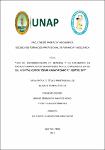Uso de antimicrobianos de reserva y su estimación en gastos hospitalarios ocasionados por su consumo en la UCI del Hospital Iquitos "César Garayar García". Iquitos, 2017

View/
Date
2019Author
Ramirez Wong, Irwing Fernando
Pizango Ferreyra, Eddie
Metadata
Show full item recordAbstract
En la presente investigación se caracterizó el uso de antimicrobianos de reserva y su estimación del gasto hospitalario ocasionados por su consumo en la Unidad de Cuidados Intensivos (UCI) del Hospital Iquitos “Cesar Garayar García”, 2017. El estudio fue de tipo descriptivo, y prospectivo, con diseño no experimental transversal y la información procedió.
Los antimicrobianos de reserva identificados del petitorio nacional de medicamentos esenciales dispensados en UCI del Hospital Iquitos “Cesar Garayar García” fueron 9: Aciclovir 250mg, Ceftazidima 1g, ceftriaxona 1g, ciprofloxacino 2 mg/ml, fluconazol 2 mg/ml, imipenem 500 mg + cilastatina 500 mg, meropenem 500 mg, metronidazol 5 mg/ml y vancomicina 500 mg. Durante el año 2017, el total de antimicrobianos prescritos sumaron 10 023 unidades de antimicrobianos, las cuales 6009 unidades de antimicrobianos (59,95%) corresponde a antimicrobianos de reserva; siendo 1646 unidades de antimicrobianos de reserva (16,42%) prescritas en UCI, representandolos de mayor consumo los antimicrobianos de reserva ceftriaxona (21,29%) y meropenem (20,94%). Los gastos hospitalarios ocasionados por consumo de antimicrobianos de reserva en UCI, equivale a S/. 6302,93; que representa el 29,69% del gasto total y además, se puede observar que los antimicrobianos de reserva que generaron mayores gastos hospitalarios en UCI fueron el meropenem 500 mg y la ceftriaxona 1g., con S/. 3091 y S/. 853,38 respectivamente.
Se concluyó los antimicrobianos prescritos en todos los servicios sumaron un total de 10023 unidades de antimicrobianos, siendo febrero y mayo, los meses de mayor porcentaje de antimicrobianos prescritos con 11,03% y 9,46% respectivamente y en cuanto al gasto total que generaron los 9 antimicrobianos de reserva en los diferentes servicios sumaron S/. 21225,17. De este total,el S/. 6302,93 fueron gastos generados en la Unidad de Cuidados Intensivos, equivalente a 29,69%, evidenciando un promedio de S/. 525,24 de gasto hospitalario mensual.
El Meropenem y la Ceftriaxona, fueron los antimicrobianos de reserva que generaron mayores gastos hospitalarios con S/. 3091 y S/. 853,38, respectivamente evidenciando un uso racional de los antimicrobianos en UCI. The current research was characterized by the use of reserve antimicrobials by the use of reserve antimicrobials and their estimate of hospital expenses causes by consumption in the Intensive Care unit (ICU) of Iquitos hospital “Cesar Garayar Garcia”. The study was descriptive and prospective with non-experimental design. The reserve antimicrobials identified from the Iquitos Hospital´s national request for essential medicines dispensed in Iquitos hospital “Cesar Garayar Garcia” were 9: Acyclovir 250mg, Ceftazidima 1gr, Ceftriaxone 1gr, Ciprofloxacin2mg/ml, fluconazole 2mg/ml, imipenem 500mg + cilastatine 500mg, meropenem 500mg, metronidazole 5mg/ml and vancomycin 500mg, being the most in-demand injectables. During the year 2017, the total prescribed antimicrobials totaled 10023 units, 6009 (59.95%) were reserve antimicrobials, of which, 1646 units (16.42%) were prescribed in ICU, of which ceftriaxone and meropenem accounted for the highest proportion with 21,29% (431) and 20.94% (424) respectively. With regard to the estimate of hospital expenses caused by consumption of reserve antimicrobials in ICU, they totaled 6302.93 S/., representing 29.69% of total expenditure. The reserve antimicrobials with the greatest representative expenditure in ICU, from highest to lowest were: Meropenem S/. 3091, Ceftriaxone S/.853,38, Vancomycin S/.686,34, Ceftazidima S/.606,96, Cilastatin + imipenem S/.554,84, Fluconazole S/184,4, Metronidazole S/. 155,87, Ciprofloxacin S/.146,26, Acyclovir S/.23.88. It is concluded that there is a rational use of antimicrobials in ICU, demonstrating a culture of prescription to respect what is indicated and a significant relationship to the costs of antimicrobials.
Collections
- Tesis [295]
The following license files are associated with this item:

